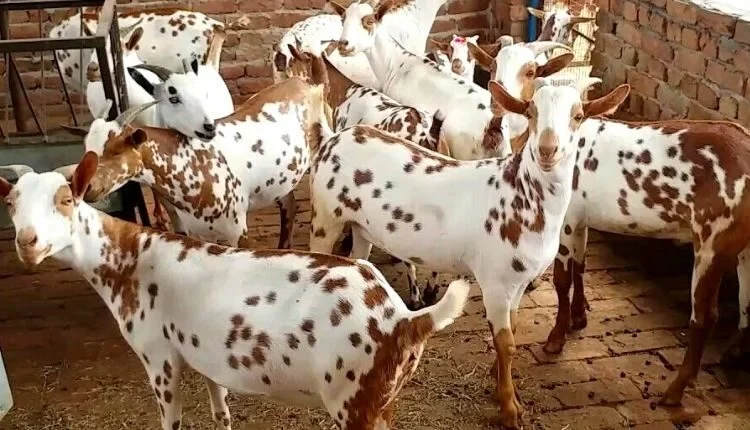Goat rearing in a scientific way will earn 3 to 4 times the cost
Adopt scientific methods in goat farming, only then there will be good profit in comparison to the cost.
Goat rearing is economical and profitable in every respect. Then whether they are reared at the domestic level of two-four goats or in the number of dozens, hundreds or thousands under small-big commercial form. Not only the initial investment in goat farming is very less, but the cost of maintenance of goats and their fodder and water is also very less. The ratio of income from goat farming can be up to 3 to 4 times against the cost, provided it is done in a scientific way.

How to choose the right breed of goat?
There are at least 103 breeds of goat in the world. Of these, 21 breeds are found in India. Prominent among these are Barbari, Jamunapari, Jakharana, Beetal, Black Bengal, Sirohi, Kachhi, Marwari, Gaddi, Osmanabadi and Surti. The abundance of goats of these breeds is found in different areas of the country. According to the 2019 Livestock Census, there are around 14.9 crore goats in the country. In the total livestock of the country, goats and sheep occupy the second place after cow-buffalo.
Most of the goat breeds like to graze while roaming. That is why it is necessary to have shepherds with them. But goats of Barbari breed, which are abundantly found in the plains of Uttar Pradesh and the Ganges, can also be reared by tying them to pegs in less space. Because of this specialty, scientists advise that if a farmer or herdsman does not have proper arrangements for grazing goats, then he should raise goats of Barbari breed and if there is a system of grazing, then Sirohi breed goats would earn better.

Characteristics of the Barbari breed
Barbari is such a breed, which does not have the hassle of grazing. They have the ability to give three to five kids at a time. Their height is small but the body is quite stout. They are more agile than other breeds. Barbari breed develops rapidly, that’s why its lambs become marketable only after an year.
Goat of Barbari breed gives about one litre of milk daily. It can be kept at low cost and anywhere. They are less prone to diseases, so maintenance is easy. Its meat is considered very tasty. That’s why it fetches good price in the market. At the time of Bakrid, cattle rearers of Barbari get even better prices. Barbari goat can also be reared in shed of farm house by elevated plastic flooring method (stall-fed method). In this method, the quantity and quality of feed is controlled according to the age and requirement of the goats. In this, it is very easy to keep the cleanliness of the place where the goats live.
Goat Farming Training
Mathura-based Central Goat Research Institute [Phone: (0565) 2763320, 2741991, 2741992, 1800-180-5141 (Toll Free)] and Lucknow-based The Goat Trust (Mobile – 08601873052 to 63) for goat rearing in the year Runs the training course four times. In this, guidance is also given to those who rear goats commercially. Apart from this, training related to goat rearing can also be taken from Krishi Vigyan Kendra.
Use scientific methods
According to Dr. MK Singh, Principal Scientist, Department of Animal Genetics and Product Management, Central Goat Research Institute, “by rearing goats in a scientific way, animal rearing farmers can double to triple their income. For this, selecting an advanced breed of goat, impregnating them at the right time and arranging fodder and water by adopting the stall feeding method proves to be extremely beneficial. In North India, goats should be impregnated during September to November and April to June. The mortality rate of newborn lambs is less in goats that get pregnant at the right time.
Cleanliness is most important
Most of the farmers are indifferent towards the cleanliness of the goat pen. This greatly increases the risk of diseases occurring in goats. That’s why if the floor of the enclosure is made of mud, its layer of one to two inches should be turned from time to time because it destroys the parasites living there. The drier the soil, the lesser will be the diseases in the goats.
Mother’s first milk
Goat owners often complain that a goat has three kids, but only one survives. This is usually because the goat’s milk doesn’t last. That’s why when the goat is pregnant, she should be given a lot of green fodder and mineral salts. Cattlemen do not let the child drink milk until the jer falls, while the sooner the child drinks the first milk (giggle) of the mother, the faster their immunity will increase and the mortality rate will decrease.
Feed and fodder
Most of the goat farmers do not pay attention to the diet management of goats. After grazing them, they tie them to a peg and leave them. While goats should be given proper fodder even after grazing, so that their meat and milk can increase. Children of three to five months should be fed green leaves along with grains in fodder.
Slaughter age i.e. 11 to 12 months old kids used for meat should have 40 percent grains and 60 percent dry fodder. Milking goats should be given about 400 grams of grains daily along with fodder. Breeding adult goats should be given green fodder and 500 grams of grains along with dry fodder daily.
For the nutrition of goats, there should be dry fodder along with grain daily. The feed should contain 57 percent maize, 20 percent groundnut cake, 20 percent bran, 2 percent mineral mixture and 1 percent salt. Dry fodder should consist of dry leaves, straw of wheat, paddy, urad and arhar. Make sure to give sugarcane syrup to the goats in cold days. If goats get such nutritious food, then their meat and milk will increase tremendously and ultimately the income of the farmers will double to three times.
How to manage fertility?
Get breeding done in female and male of same breed only. Mature male goats should be one and a half to two years old. Keep in mind that the child born from a goat should not be made pregnant by the same goat. Means, don’t let father-daughter inbreeding happen. This can lead to genetic disorders. One goat is sufficient for breeding from 20 to 30 goats. Make the female mate with the male only after 12 hours of heat rise. Increase the quantity of grains in the food of goats before parturition.
How to manage lamb?
After delivery wipe the lamb with a clean cloth. Cut the umbilical cord with a clean and new blade and apply iodine tincture on it. Let the lambs drink the mother’s first milk immediately after birth. When the lambs are 15 days old, start giving them green fodder and grains and gradually reduce the amount of milk. Get the lambs vaccinated after three months of age. Contact the veterinary hospital for this. There all vaccines are given free of cost.

Sell goats only by weight
It is profitable to sell the goats only after nine months, because by then they are sufficiently developed. For selling, nomadic traders should be avoided because often they give low price to goat rearing farmers. That’s why one should try to sell goats directly to animal market or butcher or slaughter house and at the time of selling goat’s price should be fixed according to its weight. Awareness about these things is very important among goat farmers, otherwise their profit can be very less.
Incentive Scheme for Goat Farming
Most of the state governments run schemes to encourage goat farmers to take loans from banks at concessional rates. Farmers should contact the nearest bank, Krishi Vigyan Kendra or veterinary hospitals regarding this.
Other precautions
For cleaning the equipment related to goat rearing, use disinfectants only after consulting the veterinarian. Give nutritious food to the goats, do not feed them rotten and stale food, otherwise they may fall ill. Before buying goats, do show them to the veterinarian, because there are some diseases in goats, due to which even healthy goats can die due to contact and infection. Burn or bury a goat that dies of disease.
Contact us: If farmers want to share information or experiences related to farming with us, then they can do this by calling us on the phone number 9599273766 or by writing an email to [email protected] or by sending your recording. Through Kisan of India, we will convey your message to the people, because we believe that if the farmers are advanced then the country is happy.



